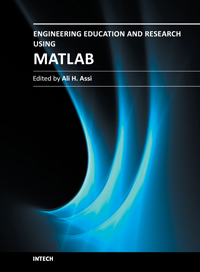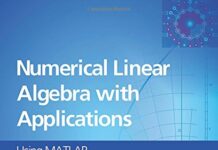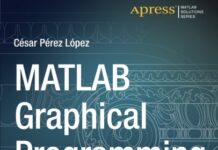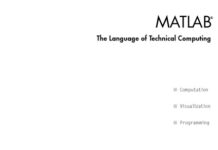| Book Name: | Engineering Education and Research Using MATLAB |
| Category: | MATLAB |
| Free Download: | Available |
Engineering Education and Research Using MATLAB

Book Description
MATLAB is a software package used primarily in engineering for signal processing, numerical data analysis, modeling, programming, simulation, and computer graphic visualization. In the last few years, it has become widely accepted as a helpful tool, which has led to a big rise in the number of scientists and universities that use it.
This book consists of 20 chapters presenting research work using MATLAB tools. There are chapters on how to program and make Graphical User Interfaces (GUIs), dynamic systems, electric machines, signal and image processing, power electronics, mixed-signal circuits, genetic programming, digital watermarking, control systems, time-series regression modeling, artificial neural networks.
Table of contents :
1. Introduction
2. Variety, modelling and representation of multiphase winding schemes
2.1 Graphical representation convention
2.2 Modeling assumptions
3. Multiphase machine modelling through Vector-Space Decomposition
3.1 Selection of the conventional multiphase model
3.2 Geometrical transformation into conventional winding scheme
3.3 Machine model in conventional multiphase variables
3.4 VFD transformation matrix
3.5 Machine model in transformed coordinates
4. VSD model implementation in the Matlab/Simulink environment
4.1 Implementation of multiphase machine model in conventional phase variables
4.2 Interface with external blocks
4.3 Model parameterization, initialization and adaptation to different multiphase machines
5. Examples of application
6. References
De-Noising Audio Signals Using MATLAB Wavelets Toolbox
1. Introduction
2. Basic audio theory
2.1 Recording audio signals in Simulink/MATLAB
3. Basic noise theory
3.1 Signal to noise ratio
3.2 White noise
3.3 Additive White Gaussian Noise Model (AWGN)
3.4 Adding noise using MATLAB
4. Wavelets theory
4.1 One stage filtering: Approximations and details
4.2 Multiple-level decomposition
4.3 Number of levels
4.4 Wavelet reconstruction
4.5 Wavelet using MATLAB
5. Sine signal example
6. Audio signal example
7. Graphical Interface using GUIDE
8. Conclusions
9. Acknowledges
10. References
A Matlab Approach for Implementing Control Algorithms in Real-Time: RTWT
1. Introduction
2. Application description: Lungs function test
3. Definitions and characteristics: Real-time systems
4. Implementation of real-time controllers using RTWT1
4.1 Overview on RTWT
4.2 Real time kernel
4.3 System concepts
4.4 Installation of the software RTWT
4.5 Hardware I/O boards
5. Application of the real-time control in a lung function test device
5.1 Implementing the simulink model
5.2 Experimental results
6. Conclusions
7. References
MatLab in Model-Based Design for Power Electronics Systems
1. Introduction
2. Slip energy recovery (SER) system
2.1 Circuit configuration
2.2 Model implemented in MatLab/Simulink
2.3 Simulation results
2.4 Harmonic analysis
2.5 Experimental results
2.6 Conclusions
3. Power electronic converter for a fuel cell (FC) system
3.1 Requirements and selection of the converter topology
3.2 Model of the converter in MatLab/Simulink
3.3 PEM Controller
3.4 Simulation results
3.5 Experimental results
3.6 Conclusions
4. Conclusions
5. Acknowledgment
6. References
Mixed-Signal Circuits Modelling and Simulations Using Matlab
1. Introduction
2. Top down design approach
3. Mixed-signal integrated circuits
3.1 Basic building blocks of mixed-signal circuits
3.2 Simulink blocks that can be used for mixed-signal modules
4. System level design
4.1 The basics of a S-. A/D converter design
4.2 Synthesis of a discrete time noise transfer function
4.3 Simulink model
4.4 Limit cycles analysis
4.5 Scaling
5. High level modelling of the mixed-signal circuits
5.1 Modelling Switched-Capacitor (S-C) circuits
5.2 Capacitor ratios
5.3 Adding circuit design parameters to the model
5.4 Quantizer model
5.5 Simulation and analysis
6. Decimator
7. Conclusion
8. Acknowledgment
9. References
Control Optimization Using MATLAB
1. Introduction
2. PID regulator
3. LQR regulator with feed-forward controller
3.1 Results and simulation after using LQR
4. PI-MIMO regulator
5. Case studies
5.1 Inverted pendulum
5.2 Modelling of a robotic arm
6. Conclusion
7. References
MATLAB GUI Application for Teaching Electronics
1. Introduction
2. Operational amplifiers
2.1 Inverting amplifier
2.2 Non-inverting amplifier
2.3 Voltage follower
2.4 Summing amplifier
2.5 Differential amplifier
3. Basic electric circuits
3.1 Voltage divider
3.1 Current divider
4. Graphical MATLAB-based tool
4.1 GUI layout and programming
4.2 Running the GUI
5. Conclusion
6. References
MATLAB-Assisted Regression Modeling of Mean Daily Global Solar Radiation in Al-Ain, UAE
1. Introduction
2. Methodology
2.1 Procedure
2.2 Definition of the statistical error parameters
3. Conclusion
4. Acknowledgment
5. References
Using MATLAB to Develop Artificial Neural Network Models for Predicting Global Solar Radiation in Al Ain City – UAE
1. Introduction
2. Background
2.1 Neural network
2.2 Multilayer preceptor (MLP)
2.3 Radial Basis Function (RBF)
3. Problem definition
4. Designing and programming ANN models
4.1 Designing ANN models
4.2 Programming the neural network model
5. Results and discussion
6. Conclusion
7. Acknowledgment
8. References
Fractional Derivatives, Fractional Integrals, and Fractional Differential Equations in Matlab
1. Introduction
2. Fractional calculus fundamentals
2.1 Special functions
2.2 Fractional derivatives and integrals
2.3 Numerical methods for fractional calculus
3. Ordinary fractional differential equations
4. Partial fractional differential equations
5. Nonlinear fractional differential equations
6. Conclusion
7. References
Analysis of Dynamic Systems Using Bond Graph Method Through SIMULINK
1. Introduction
2. Bond Graph method
2.1 Bond Graph basis
2.2 Mechanical example
3. Introduction to Simulink
4. Simulink application
5. Application example
5.1 Free vibration
5.2 Forced vibration below natural frequency
5.3 Forced vibration at natural frequency
5.4 Forced vibration up to natural frequency
6. Two Degrees of Freedom Model
7. Conclusion
8. References
Solving Fluid Dynamics Problems with Matlab
1. Introduction
2. Instabilities in lid-driven cavities
2.1 Lid-driven cavity flow.
2.2 Use of Matlab for the solution of the discrete system
2.3 Results for lid-driven cavity
3. Flow past circular cylinders
4. Transonic flows past airfoils
4.1 The mathematical model
4.2 The use of GUIs
5. Conclusions
6. References
The Use of Matlab in the Study of the Glass Transition and Vitrification in Polymers
1. Introduction
2. Theoretical aspects
3. Three step cycles
3.1 Phenomenology
3.2 The peak shift method
4. Temperature modulated DSC (TMDSC)
5. Crosslinking reaction in thermosetting polymers
5.1 Theoretical aspects of cure kinetics
5.2 Cure reaction with vitrification
6. Conclusions
7. Acknowledgement
8. References
Advanced User-Interaction with GUIs in MatLAB�
1. Introduction
2. SVA-FEA overview
2.1 SVA-FEA data structure
2.2 SVA-FEA software: handling MSC NASTRAN� input files
2.3 SVA-FEA software: selecting mesh nodes
2.4 SVA-FEA software: Tree view implementation
2.5 SVA-FEA software: Assembly tree implementation
2.6 SVA-FEA software: handling MSC NASTRAN output files
2.7 SVA-FEA software: Post-processing simulation results
3. PROMesh overview
3.1 PROMesh software: MMP and user interaction
4. Conclusions and final remarks
5. References
Using MATLAB to Achieve Nanoscale Optical Sectioning in the Vicinity of Metamaterial Substrates by Simulating Emitter-Substrate
1. Introduction
2. Modeling the metamaterial coated substrate
3. Fitting the experimental data to the model
4. Optimizing the model and code
5. Example
6. Modifications & extensions
7. Concluding remarks
8. References
A Methodology and Tool to Translate MATLAB�/Simulink� Models of Mixed-Signal Circuits to VHDL-AMS
1. Introduction
1.1 Summary of related work
2. Digital-to-analogue converter modelling
2.1 The R-2R ladder network
2.2 Mathematical model that represents the R-2R ladder
3. Data converter models implemented in MATLAB�/Simulink�
3.1 DAC08 modelled in MATLAB/Simulink
3.2 AD7524 modelled in MATLAB/Simulink
3.3 AD5450 modelled in MATLAB/Simulink
4. The MS2SV model conversion toolbox
4.1 Using the MS2SV toolbox
4.2 MS2SV toolbox evaluation
5. Conclusions
6. Acknowledgments
7. References
Automated Model Generation Approach Using MATLAB
1. Introduction
2. Review of automated model generation approaches using MATLAB
3. The multiple model generation approach using MATLAB
3.1 Introduction to least square estimate
4. Results and discussions
4.1 A single model detection
4.2 High level fault modeling (HLFM)
5. Conclusion
6. Acknowledgment
7. References
A Matlab Genetic Programming Approach to Topographic Mesh Surface Generation
1. Introduction
2. Previous works
3. Genetic programming
3.1 Genetic programming operators
4. A GA toolbox for MATLAB
5. GP structures in MATLAB
5.1 Function evaluation
6. Estimation of topographic surface by means of GP toolbox in MATLAB
7. Results analysis
8. Conclusions
9. Aknowledgment
10. References
Matlab Solutions of Chaotic Fractional Order Circuits
1. Introduction
2. Fractional calculus
2.1 Fundamentals
2.2 Fractional order differential equations
3. Fractional order circuits
3.1 Basic properties of fractional order circuits
3.2 Chaotic fractional order circuits
4. Conclusion
5. References
Digital Watermarking Using MATLAB
1. Introduction
2. Basic image processing commands in MATLAB
2.1 Loading an image
2.2 Displaying an image
2.3 Creating an image
3. Watermarking methods
3.1 Watermarking in spatial domain
3.2 Watermarking in spectral domain
3.3 Watermarking in hybrid domain
4. Evaluation of watermarking methods
4.1 Imperceptibility
4.2 Robustness
4.3 Capacity
5. Conclusion
6. Acknowledgment
7. References
Engineering Education and Research Using MATLAB PDF
Author(s): Ali H. Assi (Ed.)
Publisher: InTech, Year: 2011
ISBN: 978-953-307-656-0









![[PDF] Draw Buildings and Cities in 15 Minutes Draw Buildings and Cities in 15 Minutes pdf](https://www.freepdfbook.com/wp-content/uploads/2021/06/Draw-Buildings-and-Cities-in-15-Minutes-218x150.jpg)








![[PDF] Digital Image Processing An Algorithmic Introduction Using Java Digital Image Processing An Algorithmic Introduction Using Java](https://www.freepdfbook.com/wp-content/uploads/2022/06/Digital-Image-Processing-An-Algorithmic-Introduction-Using-Java.jpg)




![[PDF] 43 Years JEE ADVANCED + JEE MAIN Chapterwise & Topicwise Solved Papers 43 Years JEE ADVANCED (1978-2020) + JEE MAIN Chapterwise & Topicwise Solved Papers Physics PDF](https://www.freepdfbook.com/wp-content/uploads/2022/03/43-Years-JEE-ADVANCED-1978-2020.jpg)

![[PDF] Problems in Physical Chemistry for JEE (Main & Advanced) Problems in Physical Chemistry for JEE (Main & Advanced) Free PDF Book Download](https://www.freepdfbook.com/wp-content/uploads/2022/03/Problems-in-Physical-Chemistry-for-JEE-Main-Advanced.jpg)
![[PDF] Engineering Physics (McGraw Hill)](https://www.freepdfbook.com/wp-content/uploads/2021/05/bafc8c2685bb6823a9c56134f7fba5df.jpeg)

![[PDF] Engineering Chemistry By Shashi Chawla](https://www.freepdfbook.com/wp-content/uploads/2022/05/Theory-And-Practicals-of-Engineering-Chemistry-By-Shashi-Chawla-free-pdf-book.jpeg)
![[PDF] Chemistry: An Introduction to Organic, Inorganic & Physical Chemistry Chemistry: An Introduction to Organic, Inorganic & Physical Chemistry](https://www.freepdfbook.com/wp-content/uploads/2022/04/Chemistry-An-Introduction-to-Organic-Inorganic-Physical-Chemistry.jpg)
![[PDF] Essentials of Physical Chemistry Essentials of Physical Chemistry Free PDF Book by Bahl](https://www.freepdfbook.com/wp-content/uploads/2022/04/Essentials-of-Physical-Chemistry-bahl.jpg)
![[PDF] Biological control of plant-parasitic nematodes: soil ecosystem management in sustainable agriculture Biological control of plant-parasitic nematodes: soil ecosystem management in sustainable agriculture](https://www.freepdfbook.com/wp-content/uploads/2022/05/Biological-control-of-plant-parasitic-nematodes-soil-ecosystem-management-in-sustainable-agriculture.jpg)
![[PDF] Human Anatomy: Color Atlas and Textbook Human Anatomy: Color Atlas and Textbook Free PDF Book](https://www.freepdfbook.com/wp-content/uploads/2022/05/Human-Anatomy-Color-Atlas-and-Textbook.jpg)
![[PDF] Concepts of Biology Book [Free Download]](https://www.freepdfbook.com/wp-content/uploads/2022/05/Concepts-of-Biology.jpg)
![[PDF] Essentials of Biology [Free Download] Essentials of Biology Free PDF BOok Download](https://www.freepdfbook.com/wp-content/uploads/2022/05/Essentials-of-Biology-Free-PDF-Book-Downlaod.jpg)
![[PDF] Human Biology Book [Free Download]](https://www.freepdfbook.com/wp-content/uploads/2022/05/PDF-Human-Biology-Book-Free-Download.jpg)


